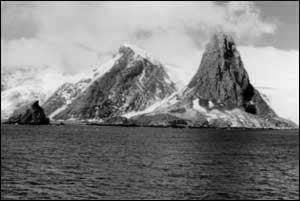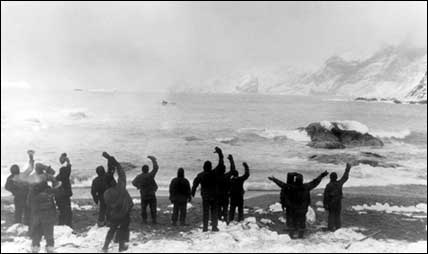|

On August 8, 1914, four days after the First World
War began, Shackleton and his crew of seamen and
scientists set sail on the Endurance
from Plymouth, England. They would not be heard
from again for nearly two years.
It was a particularly cold season and the pack ice
of the Antarctic Weddell Sea extended further north
than anyone could remember. The Endurance
attempted to navigate through the pack ice to its
intended landfall. Just one days sail from
the Antarctic continent, temperatures plummeted
and the ship was trapped. Frozen fast for ten months,
the Endurance was eventually
crushed by ice pressure. Shackleton and the 28 crew
members were forced to abandon ship on October 27,
1915. They were stranded on the ice.
 |
After five months
of exposure and a lifeboat escape to desolate
Elephant Island, Shackleton recognized their
increasingly desperate situation. Rather than
endure yet another Antarctic winter with little
shelter and less food, he took a bold gamble.
On April 24, 1916, he and five crewmen set forth
in the 22-foot James Caird,
braving 70-foot waves and 800 miles of treacherous
Antarctic seas to reach South Georgia Island.
They landed safely 17 days later, having achieved
what is widely considered one of the greatest
boat journeys in maritime history. |
Unfortunately, the only help was at Stromness Stationstill
150 miles away by sea, or 22 miles over rugged, uncharted
mountains. With two of his men, Shackleton trekked
for 36 hours in flimsy clothing and worn boots with
only screws from the Caird
driven through the soles for traction. When they finally
arrived, they were greeted with disbelief and awe.
Within hours, a ship was dispatched to collect the
rest of the Caird party.
But it would take three failed attempts and more than
three months to finally rescue the men left behind
on Elephant Island. Finally, on August 30, 1916, the
trawler Yelcho made it
to Elephant Island and retrieved the stranded men.
On September 3, the Yelcho
arrived, with Shackleton and his entire crew, in Punta
Arenas, Chile. All 28 men had survived the grueling
22-month odyssey.
 |
Epilogue
Shackleton himself best expressed the enormity and
ferocity of the adventure: Not a life lost,
and we have been through Hell.
Shackleton returned to a world still torn by World
War I. Some of the crewmen who had survived two
years in the Antarctic were soon killed in the fighting.
Shackleton himself set out to pick up the pieces
of the other half of his expedition: the Ross Sea
depot-laying party in the Aurora,
who were to have aided the trekkers walking across
the continent. Like the men of the Endurance,
they were caught in the horrific pack ice of that
year.
In 1921, Shackleton set out again for Antarctica
in the Quest, in the
company of several hands from the Endurance.
He died of a massive heart attack January 5, 1922,
on South Georgia Island, where he was buried with
all honor.
Today, Shackleton is revered as a leader who not
only put his crew's welfare before personal glory,
but who, as author Caroline Alexander puts it, "elicited
from his men strength and endurance they had never
imagined they possesssed."

Links and book list about Shackleton
and Antarctica
Buy books about Shackleton
Back
|